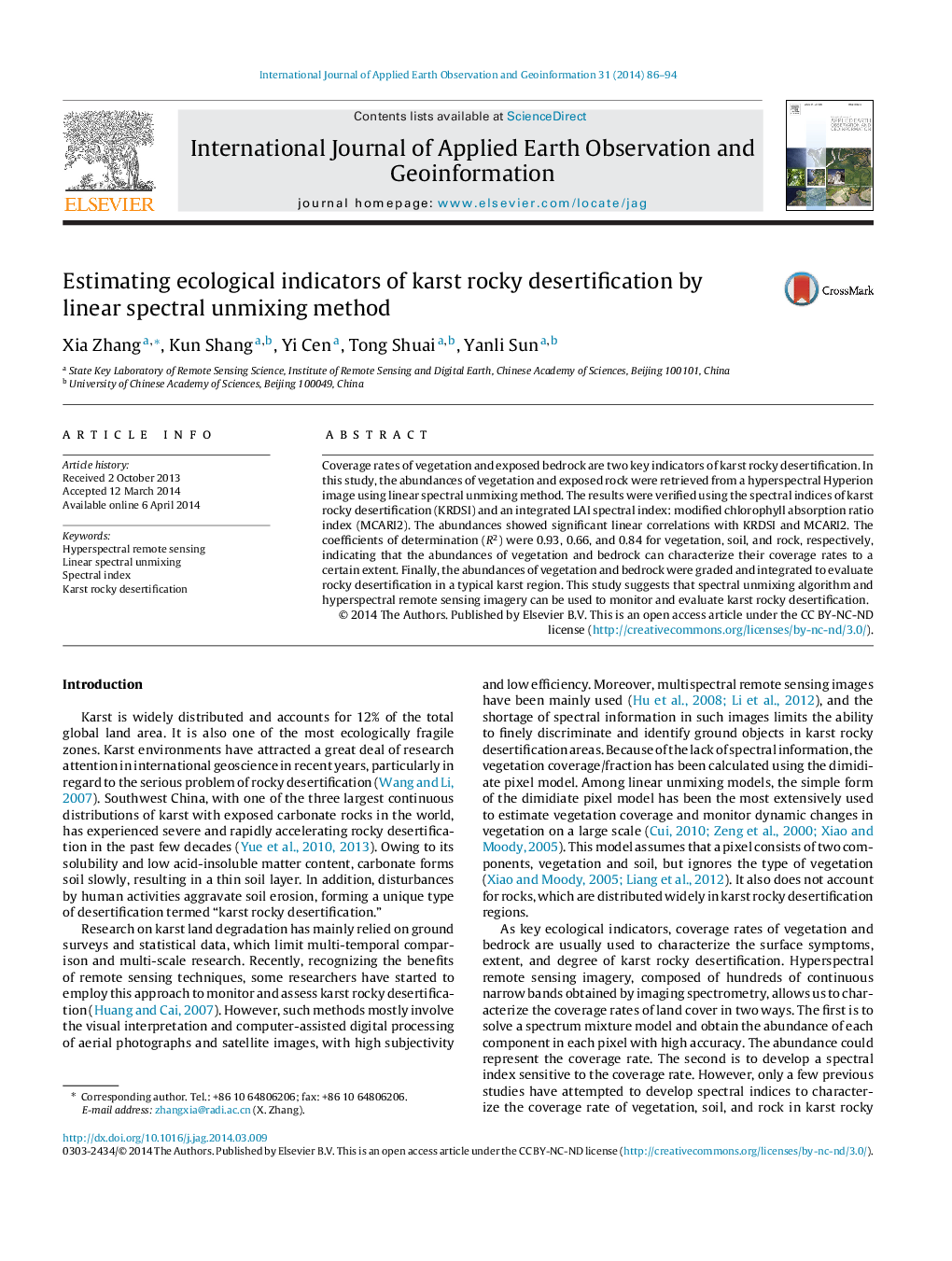| کد مقاله | کد نشریه | سال انتشار | مقاله انگلیسی | نسخه تمام متن |
|---|---|---|---|---|
| 6348903 | 1621828 | 2014 | 9 صفحه PDF | دانلود رایگان |
کلمات کلیدی
مقدمه
شکل 1 نقشه مکان های مورد مطالعه و ناحیه تصویربراداری هایپریون. متوازی الاضلاع تیره در سمت چپ تصویر نشان دهنده مکان ناحیه تصویر برداری هایپریون بر روی تصویر سمت راست است.
مکان مورد مطالعه و مجموعه داده ها
تصویربرداری فراطیفی سنجش از دور
داده های تجربی صحرایی
روش ها
شاخص های طیفی بیابان زایی سنگی کارستی
همگام سازی طیفی و بازیابی فراوانی
انتقال MNF
انتخاب عضو پایانی
جدول 1: رگرسیون خطی شاخص های طیفی و نرخ های پوشش گیاهی به دست آمده از داده های ازمایشی
شکل 2 نمایشگر اعضای پایانی پوشش گیاهی، خاک و سنگ که با SMACC استخراج شده اند.
همگام سازی طیف خطی
نتایج و انالیزها
تایید اعتبار KRDSI با داده های میدانی
شکل 3 نقشه های فراوانی بازیابی شده با استفاده از الگوریتم همگام سازی خطی محدود.
شکل 4 نقشه RMSE و هیستوگرام مربوطه برای نتایج به دست امده با استفاده از همگام سازی خطی نسبتا محدود.
شکل 5 نقشه های فراوانی بازیابی شده با استفاده از الگوریتم همگام سازی خطی کاملا محدود.
شکل 6 نقشه RMSE و هیستوگرام مربوطه برای نتایج به دست امده با توجه به همکام سازی خطی کاملا محدود.
شکل 7 انالیز های رگرسیون خطی بین تصاویر شاخص طیفی و تصاویر فراوانی مربوطه.
شکل 8 نقشه درجه بیابان زایی سنگی در محدوده مورد مطالعه.
جدول 2 : سیستم ارزیابی بیابان زایی سنگی
جدول 3: مساحت و درصد بیابان زایی سنگی
ارزیابی درجه بیابان زایی سنگی
نتایج
- Spectral indices KRDSIs had significant linear correlation with coverage rates of soil and rock.
- Reliable abundances were retrieved by partially constrained linear spectral unmixing (LSU) algorithm.
- The abundances retrieved by partially constrained LSU algorithm could characterize the coverage rates of land covers.
- Karst rocky desertification was mapped by the abundances of rock and vegetation.
Coverage rates of vegetation and exposed bedrock are two key indicators of karst rocky desertification. In this study, the abundances of vegetation and exposed rock were retrieved from a hyperspectral Hyperion image using linear spectral unmixing method. The results were verified using the spectral indices of karst rocky desertification (KRDSI) and an integrated LAI spectral index: modified chlorophyll absorption ratio index (MCARI2). The abundances showed significant linear correlations with KRDSI and MCARI2. The coefficients of determination (R2) were 0.93, 0.66, and 0.84 for vegetation, soil, and rock, respectively, indicating that the abundances of vegetation and bedrock can characterize their coverage rates to a certain extent. Finally, the abundances of vegetation and bedrock were graded and integrated to evaluate rocky desertification in a typical karst region. This study suggests that spectral unmixing algorithm and hyperspectral remote sensing imagery can be used to monitor and evaluate karst rocky desertification.
Journal: International Journal of Applied Earth Observation and Geoinformation - Volume 31, September 2014, Pages 86-94
